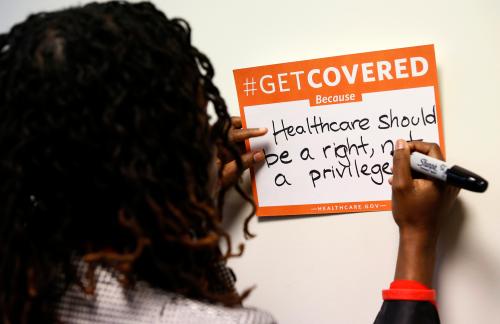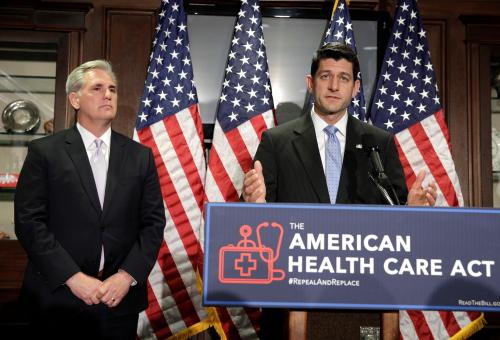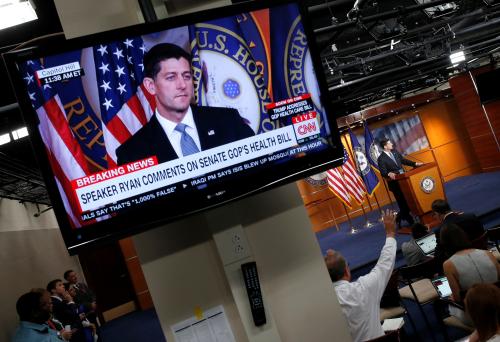This article was originally posted on Real Clear Health on February 9, 2017.
Republicans in Congress have been attacking Obamacare and vowing to repeal it for nearly seven years, and President Trump made “repeal and replace Obamacare” a central promise of his winning campaign. Now the President and his party are in charge, but they are scrambling to craft a replacement. Why are they having such trouble?
The main problem is that Republicans are a diverse bunch who opposed Obamacare for a variety of reasons. Those most focused on shrinking the size and reach of the federal government thought Washington was already too involved in health care and should pull back, not expand its role or raise taxes to pay for new health spending. Those preoccupied with personal freedom balked at being required to buy health insurance. Others thought the widespread use of insurance to fund health care was already driving health spending too high and objected to further expanding health insurance. Still, others thought broadening health coverage was a desirable goal, but that the subsidies and regulations that Obamacare used to accomplish this goal were poorly designed and transferred too much power from the states to Washington. All of these Republicans could agree on trashing Obamacare, but they did not have a common intellectual basis for designing a replacement and they still don’t.
The 2016 Republican Platform says: “Our goal is to ensure that all Americans have improved access to affordable, high-quality healthcare…” It avoids saying that the federal government has a responsibility to provide that access, which many conservative Republicans do not accept.
If you changed the goal to “all Americans should have affordable health insurance,” you would lose even more conservative Republicans—the ones who see health insurance as an undesirable way to pay for most health expenditures. They believe generous health insurance keeps people from being cost-conscious consumers looking for the most cost-effective provider of knee replacement surgery or cardiac care. If these procedures are covered by insurance, providers don’t have to compete to offer attractive prices (or even make clear to the patient what their prices are). If most of their health care costs are paid by insurance, people tend to use more care, and health care spending goes up. Hence, many Republican health care proposals feature tax subsidies that help people fund health savings accounts (HSAs), so they can shop for health care with their own money. They typically encourage health insurance coverage only for relatively rare “catastrophic” events, although they allow people to use their HSAs to buy more generous health insurance if they want it.
Limiting the generosity of health insurance is a hard political sell. Most Americans like the security of having health insurance, even for routine doctor visits.
Limiting the generosity of health insurance is a hard political sell. Most Americans like the security of having health insurance, even for routine doctor visits. Many people define a “good job” as one that comes with generous health benefits. Companies find that health benefits are effective tools for recruiting and retaining employees—and not just because benefits do not count as wages for income tax purposes. HSAs have proved popular with higher income people who face higher marginal tax rates, but it is doubtful that average workers would welcome trading a comprehensive insurance policy for an HSA.
Some Democrats aren’t fans of insurance, either. They would prefer having the government fund health care directly and avoid the extra selling costs and profits of insurance companies. But taking on powerful insurance companies is politically hazardous, as the Clinton Administration found out. President Obama co-opted the insurance companies by choosing a program that would come as close as possible to universal insurance coverage. That meant filling the coverage gap—covering people who were not insured by their employers or Medicare and Medicaid.
Obamacare shrank the coverage gap two ways: by giving states the option of expanding Medicaid to a larger group of people close to the poverty line; and by offering eligible households subsidies to buy insurance plans on electronic marketplaces. Consumers choosing among private insurance plans sounded like something Republicans ought to like, and indeed the proposal was modeled after the plan adopted by Mitt Romney when he was governor of Massachusetts. However, many Republicans found features of Obamacare objectionable, especially the mandates, the standardization of benefits, and the pre-emption of state insurance regulation.
Before the ACA, the uninsured could try to buy health insurance in the individual market, but insurance companies didn’t want to sell to people who would run up high bills. They competed for the healthy and made it expensive or impossible for the unhealthy to buy insurance. The ACA changed that, requiring companies to sell to all comers and not to penalize people in poor health by refusing them coverage, charging them more, or capping or restricting their claims. Under the new rules, insurance companies had to compete by offering more attractive products at a lower price—not by being clever at attracting healthy customers.
The new rules were popular, and individual insurance markets are functioning far better than before Obamacare. Most Republican policy makers don’t want to go back to the days when people who desperately needed health insurance found it unavailable or unaffordable. But the challenge of making competition work under the new rules was complicated by two realities: health care in America is expensive and a small number of people with serious health conditions account for a high proportion of health spending. If young and healthy people chose not to buy insurance, health plans would be stuck with high average costs and rising premiums. The higher premiums, in turn, would cause healthy people to drop their insurance, and the market would enter a “death spiral.” Hence, Obamacare mandated that everyone have insurance and penalized those who didn’t—a red flag for conservative Republicans. Moreover, Obamacare standardized health insurance plans—carriers had to offer at least a common list of “essential benefits.” Conservative Republicans objected to the “one-size fits all” benefits package, which did not allow customers a choice of which benefits they wanted. They also chafed at the federal government intervening in insurance regulation, historically a state function.
Another feature of Obamacare that Republicans didn’t like was that the subsidies designed to make insurance affordable to households were based on income in relation to the premium associated with a benchmark plan in their area. If the premiums went up or their incomes went down, purchasers got bigger subsidies so that the plans would remain affordable. This seemed fair to Democrats, but Republicans thought income-related subsidies would discourage work and premium-related subsidies would discourage competition. In Republican plans, subsidies paid into HSAs typically were uniform for everyone who did not have other insurance coverage up to some fairly high-income limit—more people than would be eligible for subsidies under Obamacare. But if a given amount of subsidy has to be spread over more people, it will either make the program very expensive or not be big enough to make a standard plan affordable to a low-income family, while more fortunate families will get more than they need. Rejecting income-based subsidies in a program aimed at making health care affordable to low-income households would likely cost significantly more than Obamacare.
The accomplishments of Obamacare are major, as many Republicans are beginning to realize. About 20 million more Americans now have health insurance that would disappear if the act were simply repealed. Uninsured rates have plummeted, including in states that voted heavily Republican. Moreover, individual insurance markets would likely implode if repeal kept the popular new rules for selling insurance and repealed the rest of the act.
But stresses also developed in Obamacare that would have needed repair even if Democrats had won the election. The mandates proved not only unpopular but also insufficient to make the young and healthy buy insurance they thought they didn’t need. Rules that narrowed the differences between premiums charged young and older customers also raised prices for the young and discouraged their participation. Moreover, while competition in the marketplaces generally kept premiums low in urban areas with plenty of providers, insurers, and potential customers, the competition was limited in sparsely populated rural areas and small towns, and premiums were often considerably higher. About a third of counties, usually rural ones, have only one company offering plans. Some insurance companies lowballed their prices, lost money, and withdrew from the market leaving consumers with even fewer choices. Also, competition to keep premiums down to attract customers led carriers to narrow their provider networks and increase deductibles. This meant that some of those who bought coverage found it hard to use when they needed care. While Republican allegations that the marketplaces were in a death spiral were exaggerations, changes were clearly needed to make competition sustainable in many areas.
All of this adds up to a dilemma for President Trump and the Republican congressional leadership. One course of action would be to stick with federally subsidized insurance and work to make the marketplaces function more smoothly and replace the features of current law that Republicans like least—replacing the mandates with incentives and generous subsidies toward the cost of the sickest enrollees, allowing some flexibility in the benefits package, etc. These approaches would cost more and require more compromises than right wing Republicans would likely support, so the president would have to forge a coalition of centrist Republicans and Democrats—a daunting prospect in this deeply polarized partisan atmosphere.
The second course of action would be to design a more conservative option that substituted tax-subsidized HSAs (combined with catastrophic insurance) for the Obamacare subsidies and rolled Medicaid expansion into a block grant that saved money over time. It’s unlikely this all could be accomplished through reconciliation and pass without Democratic votes. Even if it could (or they choose to eliminate the filibuster altogether—a possibility Senate Majority Leader Mitch McConnell has expressly ruled out), Republicans would face a lot of outraged constituents, many of them in their own party. Several Republican Senators have voiced concern about moving too quickly and leaving people without coverage. President Trump has not backed a specific plan but has promised his plan would provide “insurance for all” and that there will be a smooth transition.
One additional approach that might help resolve the conflicts would be to allow the states a lot of flexibility to decide what they want the replacement for Obamacare to be in their state. Republicans have historically had faith in state governments’ ability to manage public resources in the interests of their residents; Democrats stressed national standards and wanted Washington in charge. But this line is blurring. Obamacare contained provisions (notably the Section 1332 waiver process) that would allow states increasing latitude in spending their federal money. Governors have often proved more adept at brokering compromises across party lines than deeply polarized Washington.
There are many ways to accomplish increased state control that might be part of a replacement for Obamacare. Senators Collins and Cassidy have a startlingly straightforward proposal. Their bill would let states choose between something close to Obamacare, a Republican-type alternative featuring HSAs and subsidies unrelated to income, or nothing at all. The Collins-Cassidy bill is complicated and has many details to be worked out. Both Democrats and Republicans have already attacked it. But the concept of state flexibility might serve as a catalyst for crafting a compromise replacement proposal that could command bipartisan support.










Commentary
Op-edWhy is it so hard for Republicans to replace Obamacare?
February 9, 2017